Is your MacBook Air trackpad not clicking? You're in the proper place! With its multi-touch motions, accuracy, and delightful encounters, the trackpad on your MacBook Air is an essential input system. But what happens when its trackpad doesn't work like before? This is a serious hassle that impedes your workflow and is pretty annoying!
Luckily, this frustrating issue can be resolved quickly with some straightforward troubleshooting. In today's article, we have combined some tested and realistic solutions to fix the "MacBook Air trackpad not clicking" error easily!
| Workable Solutions | Step-by-step Troubleshooting |
|---|---|
| Fix 1. Disable Force Click | Opt for the main Apple menu, click System Settings, and select Trackpad...Full steps |
| Fix 2. Check Trackpad Settings | Hit the Apple menu at the screen's top-left edge and opt for System Preference...Full steps |
| Fix 3. Restart Your Mac | Reboot your Mac by go to the Apple menu and hit the Restart button...Full steps |
| Fix 4. Reset Your Trackpad | Opt for Go from your desktop from the top menu bar, and select Go To Folder...Full steps |
| More Tested Fixes | Delete the plist files, run Apple Diagbistics to check your trackpad, and reset NVRAM...Full steps |
Solution 1. Disable Force Click to Fix the Trackpad Not Clicking
Some major reasons for trackpad not clicking error are bugs in macOS, damaged software, malware, trackpad damage, and more. However, no matter what the reasons are that caused this error, you need to fix this ASAP, which boils down to this first solution, which is disabling force click.
MacBook's trackpad comes with a distinct array of touch gestures, where the two most typically performed actions are tap and force click. You can choose items by tapping your trackpad, and a force click will offer different alternatives according to what you click on. A force click functions similarly to a right click on a Mac. That might be the cause of your problems if you're tapping rather than clicking. The steps are the following:
Step 1. Opt for the main "Apple" menu, and click "System Settings > Trackpad".
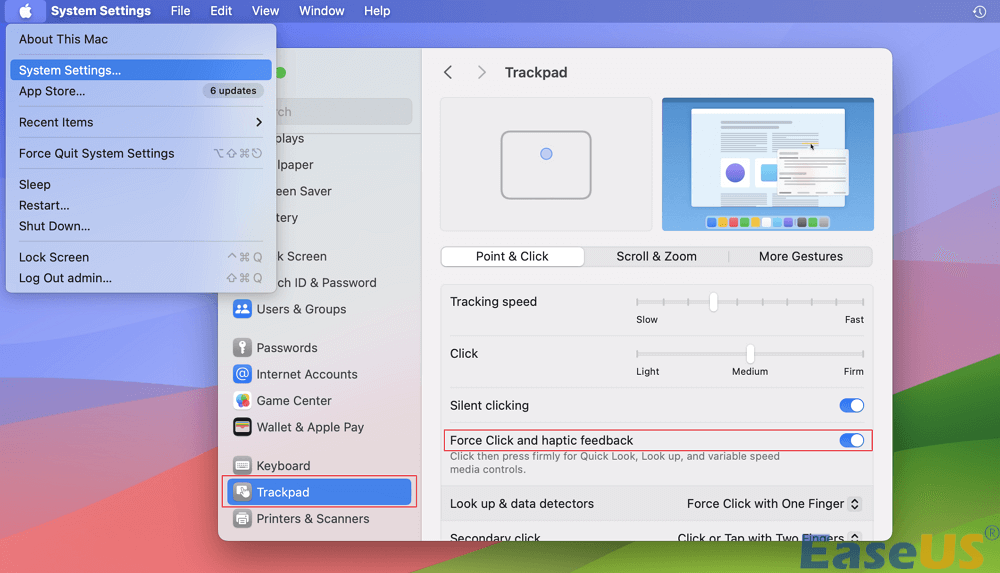
Step 2. Hit "Point & Click" and toggle the "Force Click and haptic feedback" on and off.
Step 3. Carefully adjust the pressure level you would like to apply to use "Force Click" by moving the slide under "Click".
Solution 2. Check Your Trackpad Settings
The MacBook Air trackpad not clicking error will emerge when you turn off the trackpad. You may verify your trackpad setting with the following steps:
Step 1. Hit the "Apple" menu at the screen's top-left edge and opt for "System Preferences".
Step 2. Select "Accessibility" and hit "Pointer Control".
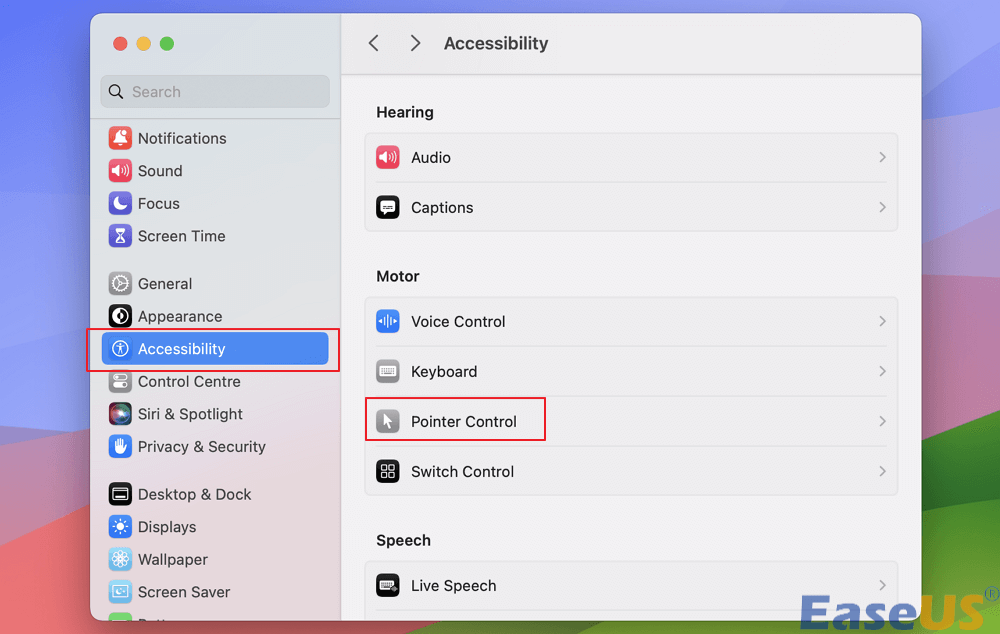
Step 3. Change the settings, which could impact the trackpad's functionality, by following the tips below:
- Untick the box labeled "Enable mouse keys".
- Hit "Trackpad Options" and toggle off "Ignore built-in trackpad when Mouse Keys is on".
- Untick "Ignore built-in trackpad when wireless or mouse trackpad is present" in case the box is ticked.
- Maximize the double-click speed.
This method also works when your MacBook Pro trackpad is not working.
Solution 3. Restart Your Mac to Fix the Trackpad Not Clicking
Although it ought to serve as the first step in any debugging process, it is rather evident. Numerous mistakes and technological hiccups can be resolved with a quick relaunch, including problems like a Mac's trackpad not functioning.
You can reboot your MacBook Air via the "Apple" menu to see if this solves your trackpad errors. In case you can't utilize the "Apple" menu to restart the device, you might be required to force shut it down by pressing and holding the "Power" button and waiting for the Mac to switch off to do it.
Add this post to your bookmark if it is informative, and share it on social media to help others learn how to fix the trackpad not working error on a MacBook Air.
Solution 4. Reset Your Trackpad to Make It Click
In case the solutions above are unable to work, it's time to reset your trackpad to make it click. These are the steps for Intel-based Macs:
Step 1. Opt for "Go" from your desktop from the top menu bar, and select "Go To Folder".

Step 2. Enter /Library/Preferences/ and hit "Return" afterward.
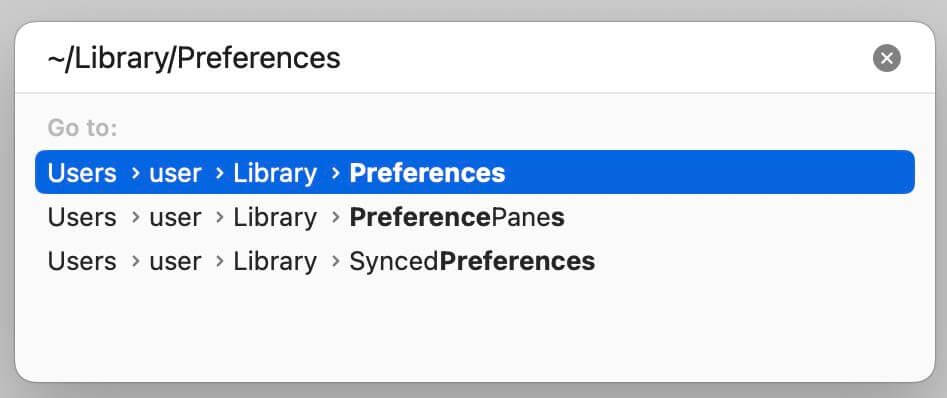
Step 3. Drag the files listed below to the Trash to be deleted after searching for them: com.apple.preference.track.plist and com.apple.AppleMultitouchTrackpad.plist
Step 4. Restart your MacBook now.
In case you have an Apple Silicon Mac, these are the steps to follow:
Step 1. Opt for the primary "Apple" menu, and go to "System Settings > Trackpad".
Step 2. Disable "Tap to click" under the "Point & Click" tab.
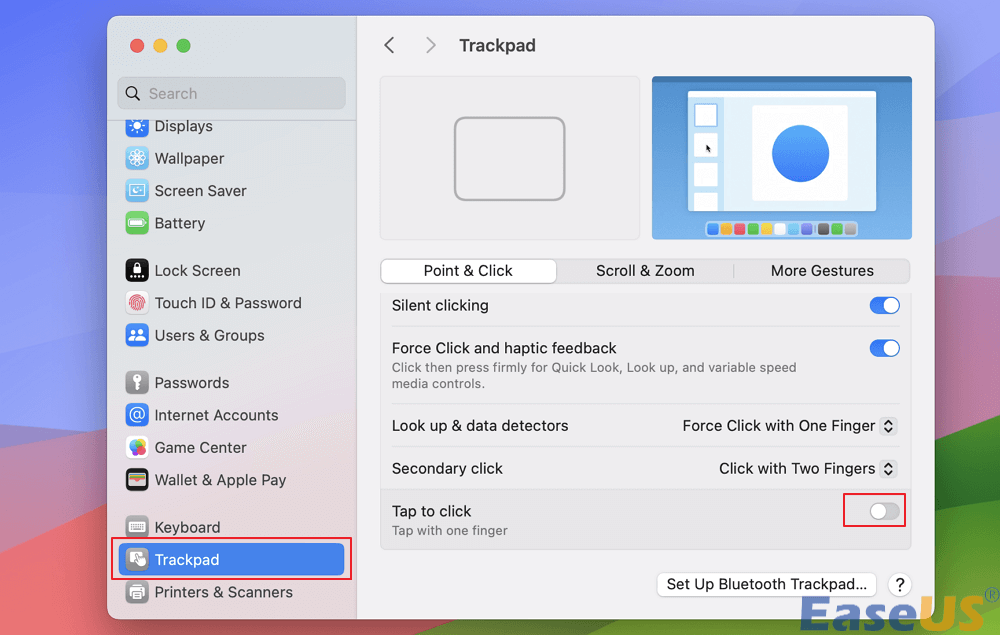
Step 3. Natural scrolling must be turned on under the "Scroll & Zoom" tab.
Step 4. It will take your trackpad back to its factory settings or default.
Solution 5. Delete Plist Files of the Trackpad
Plist files hold properties for an app, which can be deleted like any other file on a MacBook Air. The macOS utilizes such files to preserve a user's settings and details installed on a device.
To delete the Plist files connected to your trackpad and mouse, follow the steps below:
Step 1. Launch "Finder" and hit "Go"> "Go to Folder."
Step 2. Type /Library/Preferences, and hit "Go."
Step 3. Now, search for the below-mentioned plist files and delete them:
- com.apple.driver.AppleBluetoothMultitouch.trackpad.plist (Magic Trackpad)
- com.apple.driver.AppleBluetoothMultitouch.mouse.plist (Magic Mouse)
- com.apple.driver.AppleHIDMouse.plist (wired USB mouse)
- com.apple.AppleMultitouchTrackpad.plist
- com.apple.preference.trackpad.plist
You now have to restart your Mac to see if the issue has been rectified.
But you should remember that deleting the plist files of the trackpad may lead to data loss. In order to get the erased files back, you need to download and install the EaseUS Data Recovery Wizard for Mac, which can recover your deleted files without any Time Machine or iCloud backups, even after you empty the Mac Trash bin.
You can recover permanently deleted files on a Mac in 3 steps:
Step 1. Launch EaseUS Data Recovery Wizard for Mac and select the HHD/SSD where your deleted files are stored.
Step 2. Click "Search for lost files". This powerful data recovery software will quickly scan all the recoverable data on the selected disk.
Step 3. Utilize the "Preview" and "Recover" buttons to preview the files' contents, recover them, and save them to a new and safe storage location.

Solution 6. Run Apple Diagnostics to Check the Trackpad
Apple Diagnostics is beneficial for finding out hardware errors, including issues with the trackpad. Before running Apple diagnostics to check the trackpad, you need to understand if your Mac has an Intel processor or Apple Silicon by moving to the "Apple" menu > "About this Mac." Once you find the processor, go through the steps below:
Steps for the Macs with Apple Silicon ((Apple M1 chip/Apple M2 chip):
Step 1. Press down the "Power" key from your Mac. In case your Mac has a "Touch ID", you need to press and hold the "Touch ID" button.
Step 2. Allow some time for your MacBook by holding the power button until it turns on and exhibits startup options. Once you notice the "Options" label, the power button needs to be released.
Step 3. On your keyboards, press & hold "Command + D".
Steps for the Macs with Intel processor:
Step 1. Switch your Mac on by pressing the "D" key on your keyboard.
Step 2. Liberate the key once you notice a progress bar when prompted to opt for a language.
Step 3. In case pressing down the "D" key doesn't kickstart the diagnostics, you may press the "Option + D" instead.
Solution 7. Reset NVRAM
A straightforward NVRAM reset is capable of resolving several buggy issues. Therefore, you may try to reset NVRAM to eliminate this MacBook Pro trackpad not clicking error. These are the steps to follow:
Step 1. Shut down every application on the MacBook and power it off!
Step 2. Wait for a few minutes.
Step 3. Hit the "Power" button to turn the device on.
Step 4. After the screen illumination is seen, you need to press the "Command + Option + P + R" together concurrently for 20 seconds.
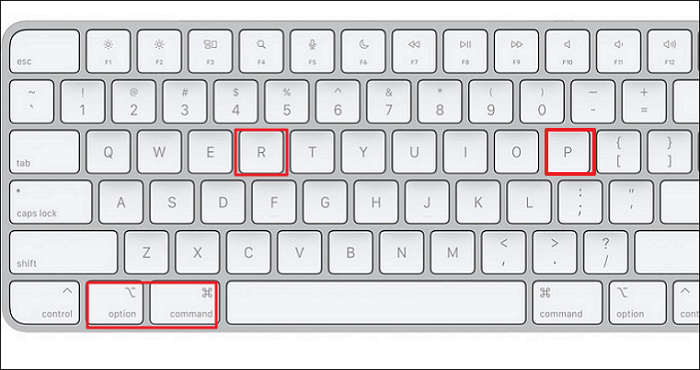
Step 5. Once you hear the startup chime, liberate the keys to let the device boot up as usual.
Conclusion
Numerous factors can contribute to the MacBook Pro trackpad not responding. They can be broadly classified into two categories: software and hardware. Software variables can be malicious programs, corrupted macOS, machine control settings, etc. However, above are the top 7 fixes in case your "MacBook Air trackpad not clicking" error happens. This error is susceptible to eliminating the stored files on your MacBook; therefore, installing EaseUS Data Recovery Wizard for Mac is recommended to retrieve the deleted files.
MacBook Air Trackpad Not Clicking FAQs
These are the FAQs to consider to understand the topic better:
1. Why is my touchpad not clicking?
A driver that is out of current or not present could be the cause of your touchpad not functioning. Using the Device Manager program to update or reinstall your touchpad components can assist in resolving the issue.
2. How do I stop the trackpad on my MacBook from clicking?
Reestablishing the trackpad to factory defaults is one of the best solutions to resolve the MacBook trackpad not clicking issue. If so, you must follow the instructions listed below:
- Move to "Apple menu > System Settings".
- It's time to go to "Trackpad" and toggle "Tap to click".
- Ensure "Natural scrolling" is opted under "Scroll and Zoom".
3. How do I make my MacBook Air trackpad click?
You need to press anywhere on the trackpad. Otherwise, it's necessary to enable "tap to click" in trackpad settings and tap simply.
Was This Page Helpful?
Brithny is a technology enthusiast, aiming to make readers' tech lives easy and enjoyable. She loves exploring new technologies and writing technical how-to tips. In her spare time, she loves sharing things about her game experience on Facebook or Twitter.
Related Articles
-
Do I Need a Heatsink for My M.2 SSD [2024 Full Guide]
![author icon]() Sherly/2024-01-11
Sherly/2024-01-11 -
How Sonoma Game Mode Boosts Your Mac Performance
![author icon]() Brithny/2024-01-11
Brithny/2024-01-11 -
Can't Read From the Source File or Disk? Find Your Solutions Here
![author icon]() Tracy King/2024-01-11
Tracy King/2024-01-11 -
Don't Pass: Is It Safe to Update BIOS?🔥
![author icon]() Jerry/2024-01-11
Jerry/2024-01-11
EaseUS Data Recovery Services
EaseUS data recovery experts have uneaqualed expertise to repair disks/systems and salvage data from all devices like RAID, HDD, SSD, USB, etc.
